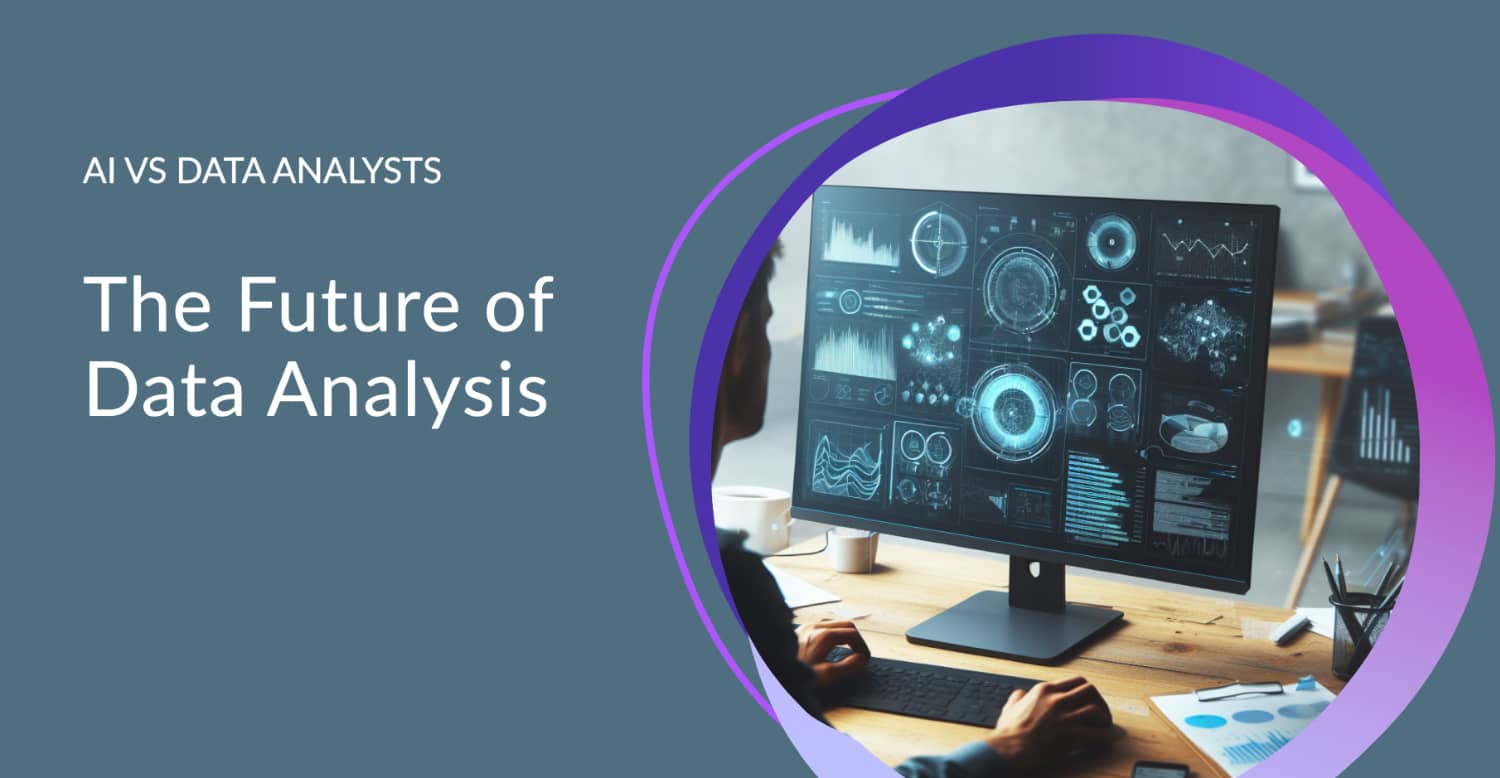The rapid advancements in artificial intelligence (AI) and machine learning have raised concerns that these technologies may automate many jobs, including those in the field of data analysis. Specifically, new generative AI models like ChatGPT have impressive natural language abilities and can already generate insights from complex data sets. This begs the question: will data analysts be replaced by AI?
While AI has the potential to automate repetitive tasks in the data analysis workflow, most experts agree it is unlikely to fully replace human data analysts in the near future. This is because AI still lacks critical human skills like business acumen, complex problem-solving, and the ability to communicate insights effectively.
However, the role of the data analyst is undoubtedly evolving in order to harness the capabilities of AI. Data analysts who learn to leverage AI as a tool rather than perceiving it as a threat stand to elevate their work and focus more on high-value tasks.
Understanding the Role of AI in Data Analysis
New AI tools like ChatGPT and Julius AI can already generate code and query data to produce insights. They can automate tasks like data cleaning, transformation, statistical modeling, and reporting. Some AI systems can even make predictions and recommendations based on patterns in the data.
However, AI has limitations when it comes to understanding nuanced business problems. Aspects like company culture, politics, economics, supply chain dynamics, and interpersonal communication require human judgment and expertise. This means key strategic tasks still rely on human data analysts.
The Evolving Role of Data Analysts
Rather than replacing data analysts, AI is shifting their role to being more focused on high-value work. With AI handling routine technical tasks, analysts can devote more time to interpreting insights, solving complex problems, crafting compelling data stories, and effectively communicating recommendations that drive business impact.
The data analysts who will thrive are those who embrace AI as an augmentation tool to enhance their existing technical abilities. These Data Analysts 2.0 will guide AI systems and validate their work rather than perceiving them as a threat.
New generative AI models like ChatGPT demonstrate impressive natural language abilities and information retrieval skills. When combined with advances in areas like machine learning and natural language processing (NLP), AI has new capabilities that are applicable to many data analysis tasks.
Capabilities of AI in Data Analysis
Here are some of the ways modern AI can augment and automate parts of the data analysis workflow:
Generate code to process, clean, and analyze data sets in languages like Python and SQL
Apply statistical modeling and machine learning algorithms to large datasets to uncover insights
Create data visualizations and dashboards to communicate key findings
Use natural language generation to summarize analysis results and create data-driven narratives
Make predictions and forecasts by detecting patterns in historical data
Generate synthetic test data to train machine learning models
Task | AI Capability |
Data Processing and Cleaning | Automate repetitive tasks like handling missing values and reformatting |
Exploratory Data Analysis | Uncover relationships and patterns in data |
Modeling and Predictions | Apply machine learning algorithms to make forecasts |
Reporting and Visualizations | Create charts, summaries, and data stories |
However, despite great progress, AI still has limitations when it comes to replicating human skills.
Limitations of AI in Data Analysis
While AI can automate parts of the data analysis workflow, human data analysts still provide key value including:
Business acumen to frame the right questions and context for analysis
Communication skills to explain technical findings simply
Strategic thinking to turn insights into impactful decisions
Creativity and intuition when dealing with complex ambiguous problems
Ensuring ethics, privacy, transparency, and bias mitigation
The future role of data analysts will focus more heavily on these differentiating human skills while leveraging AI to enhance technical capabilities.
The Evolving Role of Data Analysts
Rather than replacing data analysts, AI is shifting their role to being more focused on high-value work. With AI handling routine technical tasks like data cleaning and visualization creation, analysts can devote more time to interpreting insights, solving complex problems, crafting compelling data stories, and effectively communicating recommendations that drive business impact.
From Data Grunts to Data Storytellers
In the past, data analysts were often viewed as "data grunts" who handled dull, repetitive tasks like gathering data sets and building standard reports. The focus was purely on technical skills.
With AI automating many tedious aspects of data preparation and analysis, forward-thinking analysts are evolving into "data storytellers." These data storytellers not only uncover powerful insights, but compel others to take action on those insights.
Data storytellers have a strong blend of both technical data skills and creativity. Rather than simply building dashboards, they frame analysis results as engaging narratives targeted to influence specific audiences, whether executives, marketers or product managers.
The Rise of Citizen Data Analysts
Advances in natural language processing also enable automated analytics through AI assistants like ChatGPT. With tools that can understand conversational prompts and questions in plain language, more non-technical "citizen data analysts" can benefit from data without specialized skills.
While automated AI assistants have limitations with bias and accuracy, they open up simple descriptive analytics to a wider audience. This helps democratize data analysis so companies become more data-driven. Of course, for complex analysis, human data experts still lead the way.
Overall data analysts must embrace AI as a collaborator to elevate their impact. Technical skills remain vital, but it's the human skills where data talent creates unique strategic value.
The Skills for Future Data Analysts
While AI handles an increasing number of technical tasks, data analysts remain vital to organizations. However, the skills needed to thrive as an analyst are evolving. Here are some of the key abilities future data analysts need:
Technical Skills
With the rise of automated analytics, analysts need a strong grasp of what AI can and cannot achieve. Important skills include:
Fluency in languages like Python and SQL to generate code and queries that AI struggle with
Understanding of statistical and machine learning concepts to properly evaluate AI output
Ability to connect multiple data sources and handle large, complex data infrastructure
Testing and debugging skills to catch errors and enhance algorithms over time
Business Skills
Equally important is understanding the broader business context and what decisions need to be informed by data. Crucial skills include:
Communication abilities to compelling explain insights to non-technical stakeholders
Strategy skills to link analysis outcomes to financial impact
Industry knowledge to frame the right questions and KPIs for investigation
Leadership talent to drive culture shifts towards being more data-driven
Adaptability Mindset
With rapid technology change, being adaptable and eager to continuously learn is mandatory. Analysts must stay on top of AI advances relevant to their role.
Technical Skills | Business Skills | Foundation |
SQL, Python | Communication, Storytelling | Adaptability, Curiosity |
Statistical Expertise | Strategic Thinking | Continuous Learning |
Data Engineering | Business Acumen | Ethics and Bias Mitigation |
The analysts that thrive will have technical and business skills but also nimbleness in learning how new innovations like AI can elevate their individual and organizational success.
Examples of AI-Powered Data Analysis Tools
A number of impressive new software tools showcase the potential of AI to enhance and automate aspects of data analysis. While human guidance is still essential, these tools give a glimpse of how AI can positively disrupt traditional analytics.
Microsoft Power BI Q&A
Power BI delivers intuitive data visualizations and dashboards. Its Q&A feature allows users to query data sets by typing or voice questions in plain language. For example, "what was our sales revenue last year by product category and country?" Behind the scenes, Power BI convert this to DAX or M code to fetch the result.
Tableau Ask Data
Similarly, Tableau's Ask Data functionality handles conversational analytics. It accepts questions like "which customers spent over $500 last year?" and displays the answer visually without SQL or other coding needed. Advanced NLP parses extensive synonyms and phrasing variants.
Trifacta Wrangle Search
Trifacta Wrangle enables intuitive data cleaning and preprocessing with an innovative visual interface. Its Search capability leverages AI to suggest data transformations as users describe desired actions in plain language. This greatly accelerates the pace of cleaning messy, inconsistent data.
Tool | Capability | Key Benefit |
Power BI Q&A | Conversational Analytics | Democratizes Data Analysis |
Tableau Ask Data | NLP-powered Queries | Faster Insights for All Roles |
Trifacta Wrangle | AI-assisted Data Cleaning | 10x Faster Data Preparation |
Rather than replacing data analysts, these tools allow them to work faster and more efficiently. They can spend less time on routine work and more time interpreting findings and guiding decisions.
The Future of Data Analysis and AI Integration
As AI capabilities grow, data analysis will involve more seamless integration between human analysts and AI assistants. Rather than work in silos, smart organizations will bring them together in an optimal symbiotic relationship.
The Rise of Computer-Augmented Analysis
We will see data analysis shift to more of a collaboration between technology and people. Data analysts will provide the business context, framing of problems and final interpretation. Meanwhile, AI will handle the bulk of number-crunching, pattern identification and predictive modeling.
With analysts guiding objectives and validating results, AI takes care of the heavy data processing at computer speed. This computer-augmented approach leads to higher quality insights delivered faster.
Democratizing Access to Data Insights
No-code analytics tools powered by natural language interfaces open up data and analysis to more non-technical users. While complex analysis still needs experts, citizen data analysts can benefit from AI assistants like Claude, DataRobot and others that understand conversational prompts.
Democratized data access linked to automated visualization enables more employees to leverage analytics in their daily decisions without bottlenecking the analytics team.
The Possibilities of Responsible AI Integration
If organizations can implement AI-human collaboration responsibly by addressing areas like bias, privacy and transparency, data-driven decision making can scale across the enterprise. Teams receive tailored, trustworthy insights that lead to better outcomes.
The future possibilities for transforming decision making through responsible data analysis AI are tremendously exciting. Organizations must start their journey now to develop the tools, culture and governance required.
Data Analysts: Evolve, Don't Dissolve
The question of whether emerging AI technologies will replace data analysts contains more nuance than a simple yes or no. AI brings impressive capabilities that automate parts of the analysis workflow - but human creativity, judgment and communication abilities remain vital.
Rather than being replaced, curious analysts willing to expand their skillsets stand to have their productivity dramatically augmented by AI. They gain a powerful partner that handles tedious technical tasks, enables faster insights and opens up data democratization.
By embracing AI as a collaborator instead of a competitor, analysts can enjoy more fulfilling, impactful roles. Instead of being data grunts pulling reports, they can be data storytellers delivering compelling narratives that influence executives and frontline decision makers alike.
The future is bright for those analysts who proactively upskill in the responsible use of AI as part of their analytics toolkit. Maintaining uniquely human talents while delegating suited tasks to AI results in enhanced career opportunities rather than redundancy. The key is for analysts to evolve their roles with the wave of AI advancement rather than allowing their skills to dissolve.


